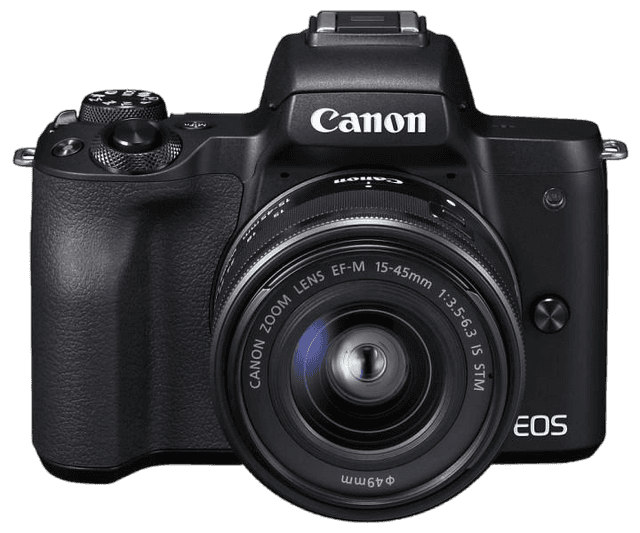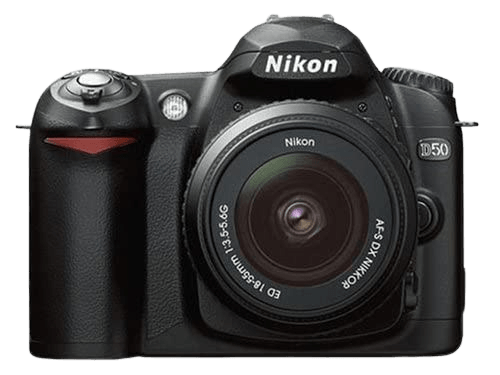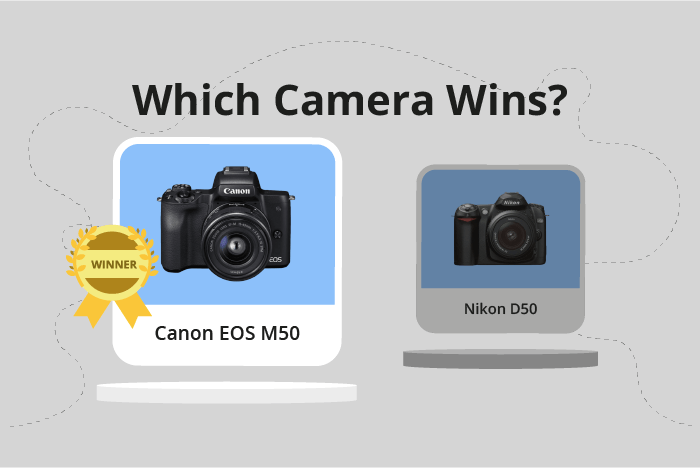Canon EOS M50 vs Nikon D50 Comparison
Canon EOS M50

Nikon D50

The Canon EOS M50 outperforms the Nikon D50 with a significant difference of 31 points in our scoring, holding a score of 59/100 compared to the Nikon D50’s 28/100. Both cameras share similarities in their specifications, such as being released with a launch price of $779 for the Canon EOS M50 and $1000 for the Nikon D50.
The Canon EOS M50 excels with its lighter weight of 390g and smaller size of 116 x 88 x 59mm, making it more convenient for portability. On the other hand, the Nikon D50 may appeal to those who prefer a DSLR camera type, despite its larger size (133 x 102 x 76mm) and heavier weight (620g).
Considering the specifications, the Canon EOS M50 is a better option for those who prioritize a lightweight and compact camera. However, the Nikon D50 may still cater to those who prefer a traditional DSLR experience.
Canon EOS M50 vs Nikon D50 Overview and Optics
The Canon EOS M50 triumphs over the Nikon D50 in the optics department with a score of 59/100, compared to the Nikon D50’s 34/100. Both cameras share some common specifications: an APS-C sensor size, no image stabilization, and lens mounts specific to their respective brands (Canon EF-M and Nikon F DX).
The Canon EOS M50 outperforms the Nikon D50 in several aspects. With 24 megapixels, the EOS M50 has a significantly higher resolution than the D50’s 6 megapixels. This results in sharper and more detailed images. The EOS M50 also has a faster shooting speed of 10 frames per second, compared to the D50’s 2.5 frames per second, which allows for better action and sports photography. Furthermore, the EOS M50 is equipped with a more advanced CMOS sensor and Digic 8 processor, contributing to its higher DXOMARK score of 58, compared to the D50’s CCD sensor and Nikon Image processing engine, which scored 55.
The Nikon D50, on the other hand, does not offer any significant advantages over the Canon EOS M50 in the optics category. The only potential benefit is the compatibility with a wide range of Nikon F-mount lenses, but this does not outweigh the numerous advantages of the Canon EOS M50.
Given the substantial differences in scores and the various superior specifications of the Canon EOS M50, it is evident that this camera is the better choice for those prioritizing optics performance. The Nikon D50 falls short in comparison and may not satisfy the needs of photographers seeking high-quality optics.
Canon EOS M50 vs Nikon D50 Video Performance
When it comes to video capabilities, the Nikon D50 does not offer any video functionality. This means that if video recording is a priority, the Canon EOS M50 is the clear choice between the two cameras.
The Canon EOS M50 boasts an impressive video score of 91 out of 100. This camera provides 4K video resolution, with maximum dimensions of 3840 x 2160 pixels. Furthermore, the EOS M50 can record at a high frame rate of 120fps, ensuring smooth and detailed footage. An additional feature is the built-in time-lapse functionality, which allows users to easily create time-lapse videos without the need for external equipment or software.
Taking into account the video capabilities of both cameras, the Canon EOS M50 is undeniably superior in this aspect. The lack of video functionality in the Nikon D50 makes it unsuitable for those who require video recording capabilities. On the other hand, the Canon EOS M50 offers high-quality video features, making it an excellent choice for users who want to capture both stunning photos and videos.
Canon EOS M50 vs Nikon D50 Features and Benefits
The Canon EOS M50 emerges as the winner in the comparison of features, scoring 70/100, while the Nikon D50 scores only 10/100. This difference of 61 points highlights the superiority of the Canon EOS M50’s features.
Both cameras share some specifications, such as the absence of GPS and the presence of WIFI connectivity. However, the Canon EOS M50 outperforms the Nikon D50 in several aspects. The EOS M50 has a larger screen size of 3 inches, compared to the D50’s 2 inches. Additionally, the screen resolution of the M50 is significantly higher at 1,040,000 dots, whereas the D50 has only 130,000 dots. The Canon EOS M50 also features a touchscreen and a flip screen, which the Nikon D50 lacks. Moreover, the EOS M50 includes Bluetooth connectivity, while the D50 does not.
On the other hand, the Nikon D50 does not have any notable advantages over the Canon EOS M50. It is important to note that the higher score of the EOS M50 does not make it a better camera; rather, it earns the higher score because it is a better camera in terms of features.
In comparing the two cameras, it is clear that the Canon EOS M50 offers more advanced and user-friendly features than the Nikon D50. The larger and higher-resolution screen, touchscreen, flip screen, and Bluetooth connectivity make the EOS M50 a more versatile and convenient camera for various photography needs. The Nikon D50, with its lower score and fewer features, falls short in comparison. Therefore, the Canon EOS M50 is the better choice for photographers seeking a camera with a greater range of features.
Canon EOS M50 vs Nikon D50 Storage and Battery
The Nikon D50 outperforms the Canon EOS M50 in storage and battery, scoring 51 points compared to the Canon’s 13 points. Both cameras have one memory card slot, with the Canon accepting SD, SDHC, and SDXC (UHS-I compatible) cards while the Nikon only accepts SD cards. Neither camera offers USB charging.
The Nikon D50’s battery life is significantly longer, providing 2000 shots compared to the Canon EOS M50’s 235 shots. The Nikon D50 uses an EN-EL3 battery, while the Canon EOS M50 utilizes an LP-E12 battery.
Although the Canon EOS M50 accepts a wider variety of memory cards, this advantage does not compensate for its significantly shorter battery life. The Nikon D50’s superior battery performance makes it a better choice for extended shooting sessions and situations where recharging is not feasible.
Canon EOS M50 vs Nikon D50 – Our Verdict
Are you still undecided about which camera is right for you? Have a look at these popular comparisons that feature the Canon EOS M50 or the Nikon D50:

